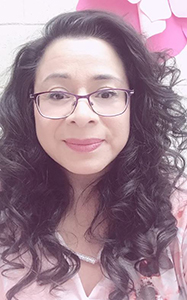January 2019 Featured Educator: Alma Maldonado

Why did you choose to become an educator? How did you come to be involved with ELL teaching? Was that something you always wanted to do or was it something you acquired because of some other experiences you had? What do you love about your job? What frustrates you as an educator?
I had been an ESL child and felt it would be wonderful to teach children who had experienced the same language difficulties I had. I remember the times when I was lying on the playground in a fetal position, being kicked by other children, because I did not fit in and I did not speak English. I am guessing that I was experiencing the silent period that I know of today. I could not speak up to ask for help. The only life support I had was a Panamanian classmate who also spoke Spanish. My father was always away because he was in the U. S. Army and my mother, who is from Durango, Mexico, did not know enough English to help me communicate with my teachers and help me with homework.
I love my job as an ESL teacher because I see myself in all the English Language Learners I come into contact with. I know what they need because I ask myself every day, “What did I wish for when I was that child? What would have helped me when I was that child? Who was there for me?”
The one thing that frustrated me in the past is that I did not get the phonics lessons I needed. This is why I get frustrated when I do not see more reading specialists in the middle and high schools working with our ESL populations.
Where do you teach? What grades? How long have you been a teacher? What is your current position and how long have you been in this role?
I love teaching in Dinwiddie, Virginia. I have been teaching ESL here for 14 years. At first, I was the only ESL teacher for eight schools, but now I am only at one elementary school that has a 16% Hispanic student population. I teach reading and math in Grades K-2. I also teach reading, math, history, and science in Grades 3-5.
My role as the ESL teacher is to support the classroom teacher, teach the ongoing content, fill in the gaps in the content areas, welcome ESL families into our school system, teach academic English Language Development, help students make a smooth adjustment with the new school culture, and to bridge the communication gap between the school and the ESL families. There is a system to all the madness and it CAN work.
Describe your class, school, and district. Please tell me a little about its location, size, and the composition of the student body? What do language services look like in your school?
My ESL room is a classroom/office. It is used for welcoming and registering new ESL families. It is also used as a safe place where students can come to recover emotionally, or it can be used as a place to learn new things or to review for a test. I have noticed, though, that the students come in here to feel happy and united. We are a happy bunch when we are learning together.
Dinwiddie, Virginia, also has a calming and positive feel to it, even though we are a diverse population. Our ESL population has grown quite a bit over the past few years, due to the low cost of living and access to the cities of Richmond and Petersburg. We are a quaint rural town with a country feel where everybody knows each other. Southside Elementary is a Title I school with a high poverty rate, where most students receive free or reduced-price lunch.
What is your approach towards supporting language learning in your classroom and school? What techniques/strategies have you found to be most effective in teaching language learners?
Language services at Southside Elementary are individualized and grouped according to the students’ needs in content and language. Effective teaching is most important, so whatever learning environment helps the students achieve their academic goals is what I deliver. I collaborate with teachers for the whole classroom, I pull out small groups, and I also sit at a table for individualized or small group activities.
Because every student learns differently and every student comes to school with different background knowledge, it is important for me to learn as much as I can about the student during the WIDA screening. This is vital information when it comes to saving time and making learning meaningful and productive. I focus on the gaps in reading, phonics, math, critical thinking, and problem-solving skills.
I like to research the best practices for acquiring a second language. For this reason, I watch what my colleagues practice and I keep and learn those teaching skills that were successful. I strongly believe that all English language teachers should be very familiar with effective teaching strategies in phonics. The most important message that I would like to share with my ESL and bilingual colleagues is that comprehensible input must be your goal at all times when introducing a new topic in content or in language.
How do you encourage students to learn? How do you accelerate their language development and ensure their equitable access to content learning?
Another important tool for any teacher is to learn how to read your students. Learn what makes them excited to learn. Know what helps them feel comfortable in your classroom. I try to make myself approachable so that when a student does not understand a concept in class or is not having a good day, they do not second guess about coming to me for help. If your students get happy and excited when they see you in the hallways, then you are doing a great deed in a little person’s life.
It is important for ESL teachers to have good communication with the school administration and teachers, because we notice when our ELs are not receiving equitable access to content learning. We can make suggestions and make a difference to ensure that our ELs are receiving comprehensible input during content learning.
One important point that I would like to highlight is that equitable access to content learning for our students has everything to do with the quality of English language teachers that our state universities are graduating or endorsing. Sometimes, when universities are in a hurry to endorse teachers, due to a shortage of, let’s say, ESL teachers, the quality of under-trained teachers hurts the English Learners; thus, equitable content learning suffers as a result.
How do you determine which language standard(s) to focus on in a lesson? Describe your planning process to address the needs of your students. How do you manage to collaborate with content area teachers?
I determine which language standards to focus on depending on the need of the students at that moment. For example, if I get a newcomer who is in fifth grade, who has some writing background knowledge in his or her first language (L1) and is trying to get through a history class, then I start off with past tense verbs, along with a list of high frequency words and a vocabulary word box that is for that particular content or lesson.
I have found that the Jenny’s model works wonders for newly arrived students. The Jenny’s model, along with the SIOP lesson plan, a couple of phonic highlights, and, of course, the WIDA standards help open up a world of enlightenment or comprehensible input for ELs. I use a lot of tools and manipulatives from the Speech department. I came upon many ESL treasures while I was browsing through a Speech catalog and found various kinds of realia that can be extremely helpful for phonics and vocabulary lessons.
As an ESL teacher, we must find ways to help our students acquire academic language using comprehensible input in all of our lessons. WIDA standards help us keep focused on our objectives while we are working our magic. I think of WIDA standards and the Can Do Descriptors as a way of guiding where I am and where I need to go with language acquisition.
It is important to get familiar and comfortable with the teachers we collaborate with. We need to communicate with classroom teachers and at the same time try not to take up too much of their time because they too are very busy. When we collaborate with classroom teachers it is important that we bring new learning ideas and tools while at the same time keeping with the rigorous lessons.
What benefits of strength do language learners bring to your classroom and school? What benefits do their families bring to schools or the surrounding community?
Believe it or not, but our students benefit the teachers just as much as they benefit from us. Students astound us each and every day. I am so proud of how far my gifted ESL piano students have learned from our piano lessons on Monday and Tuesday evenings. My ESL piano students are working on learning how to play “The Star-Spangled Banner” on the piano for school assemblies. Parents come to school to help decorate the hallways for Hispanic Heritage month and other occasions. It is amazing how ESL families are quick to jump on board with homework, projects, and school functions, just as long as they know that the school staff is there to support them in return. We work together to make positive changes, and the children get excited, too.
What methods or tools do you use to assess your students' language learning?
I personally like to give the WIDA Screener paper version myself because I can learn so much more from the student. I make a list of at least 15 focus language points before they are sent back to their classrooms. This helps me and the classroom teacher know more about the language learner’s immediate needs.
During lessons, it is important to continuously practice ongoing assessments all day long. This will reduce surprise low test scores. There is no need to be surprised like this. Visual walk-around ongoing assessments help.
How has WIDA helped you achieve your goals as an educator?
WIDA has helped me stay focused and on track with language goals throughout the school year. Before WIDA was introduced to Virginia, it was difficult to stay focused, because I had to come up with a mental map of where I was going with the language lessons.
What would you have to say or what kinds of information would you leave with educators throughout the 40 WIDA state?
I would like to remind educators of ELs to not overlook teaching dictionary skills. I know this sounds silly, but it is true. Please spend at least 15 minutes on phonics at the middle and high schools, because reading specialists are hard to find at that level. Please ask your school principals to let you go to an elementary school to observe a reading specialist. I would also like to remind us all to use more realia manipulatives, as well as real life opportunities as learning tools.
Also, use current world news to get your silent ELs to talk...it works! I was surprised that my young students were so intrigued with current world news. Another piece of advice that I have had a hard time embracing is that it is more beneficial to teach no more than four or five small new concepts instead of multiple concepts that are not taught or learned well. However, the most important tool I have come to use in my 16 years of teaching is having a big heart. Staying interested and keeping positive in our students’ lives lasts for years and years.





